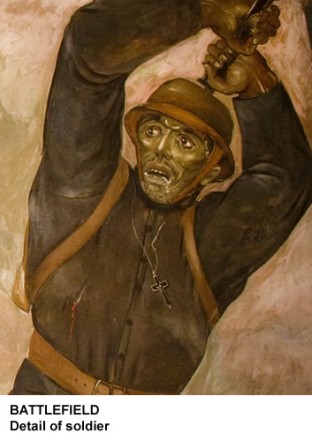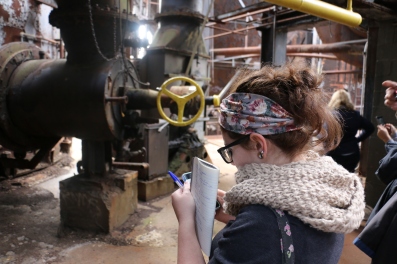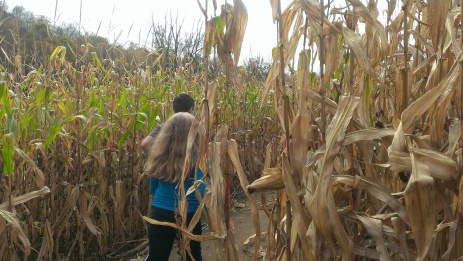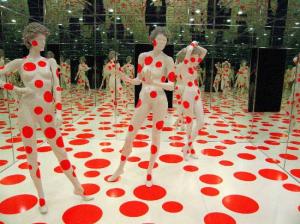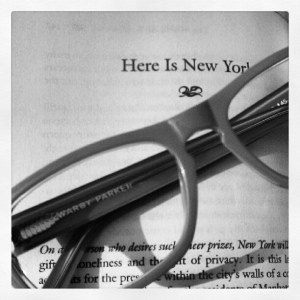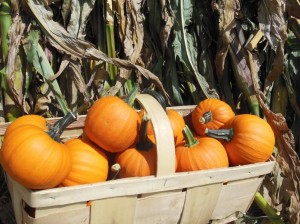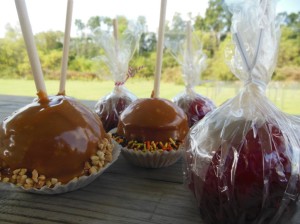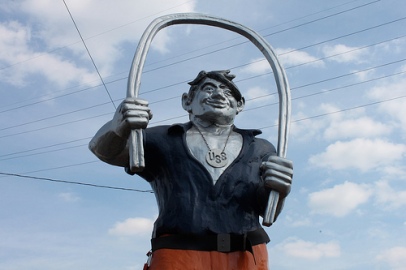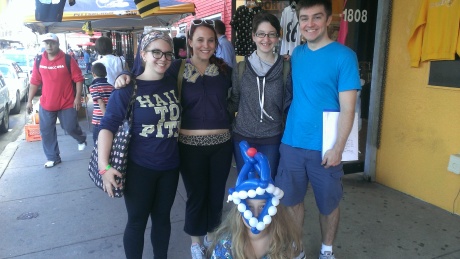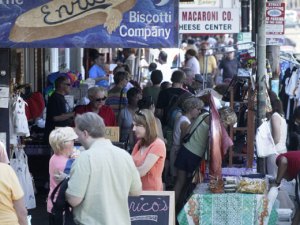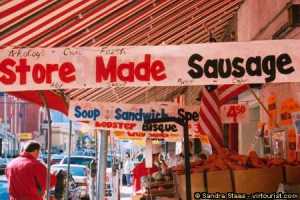Did you ever have to sit through a slide show of your Uncle Jimmy’s trip to West Palm? Have you ever had to read (or write) something called “What I Did on My Summer Vacation”? Have you ever gotten a puffy-paint t-shirt, a lava ashtray, a bell shaped like a cow, or a miniature silver-plated spoon as a souvenir of someone else’s journey? Have you ever heard someone say, “Well, you just should have been there.”
If so, you already know everything good travel writing isn’t. And this is a great place to start.
And place really is everything.
Pitt-Greensburg Travel Writing 2014
Course Rationale
You’ll learn the basics of travel writing through reading, craft lectures and hands-on practice. Every class meeting, we will venture into Pittsburgh and the surrounding areas to discover something new and write about it.
You’ll keep a travel blog where you’ll post your stories, photos and videos, as well as reading responses to our texts. You’ll read and analyze different kinds travel narratives, and learn how to craft and publish your own travel pieces.
This course is designed for anyone who’d like to try his/her hand at travel writing for targeted audiences or who would like to prepare for a career in magazine writing, publishing, or general content writing.
Prerequisite: ENGWRT 0550/Intro to Journalism or instructor permission
Course Learning Objectives
After completing this course, students will be able to:
- Research a travel destination
- Travel to destinations they’ve researched and report on the experience
- Write travel narratives and use digital-storytelling techniques to add new dimensions to their work
- Create and maintain a travel blog
- Critically read and analyze a wide variety of travel narratives
- Have a better understanding of travel-writing markets and audiences
- Have a better understanding of their cities, towns and neighborhoods and use that understanding to craft travel narratives for a variety of audiences
- Be able to generate fresh ideas for magazine articles and identify target publications
- Be able to research and report various kinds of travel articles, including how-to pieces, reviews, feature articles and reportage, essay/columns and more
- Understand the importance of revision in the writing process
- Understand the ways digital storytelling techniques are used along with traditional prose to enhance travel narratives. Students will produce digital content (photo essays, illustrations, video or audio supplements) to accompany their individual stories.
- Be able to write a query letter/pitch to an editor
- Understand the way news values and audiences shape travel narratives
- Demonstrate craft skills, a mastery of basic Associated Press style and good grammar
Required Texts:
Required Texts:
Here is New York, by E.B. White
My Kind of Place, by Susan Orlean
Moon Pittsburgh, by Dan Eldridge
Tour Anytime (online link to cell phone/walking tours) – http://www.touranytime.org
Best American Travel Writing 2013
Me Talk Pretty One Day, by David Sedaris
The Lonely Planet Guide to Travel Writing
Required Tools:
- A cell phone (to use TourAnytime)
- Reporter’s notebook/pen
- A video/camera/recording device (a smartphone is fine)
- You will need access to a computer or tablet, both at home and in class. (Computers are available for in-class use as needed – please let me know at the beginning of the term if you’ll need to borrow a computer or tablet in class or if you’ll bring your own device)
Assignments and Projects: At the beginning of the term, you will set up a blog. You’ll use your site to post your assignments for class, and as a space where you can generate and share ideas and research-findings.
You’ll set up your site during our first class. You’ll be free to use whichever blogging platform you’d like. (I use WordPress and recommend it or Google Blogger for those of you who just starting out.)
In terms of writing assignments, you’ll average one article for every class meeting, plus two additional blog entries. You’ll have a total of seven articles and 14 other general blog entries by the end of the term.
In between deadlines, you’ll revise your work and update your articles based on comments you’ll receive in workshop. Your articles will vary in length, but most will be between 500 and 900 words. All articles and revisions and general blog posts are due at the beginning of each class and should be live on your blogs by then.
Here’s a general schedule (subject to change – come to class to keep up-to-date with assignments and changes to our schedule):
Week One: Course Introduction/Blog Creation/Defining Your Passions — Westmoreland Museum of Art
Reading assignments:
Lonely Planet Guide, Moon Pittsburgh on Strip District, online research
Writing assignments: Piece on Westmoreland Museum of Art; two general blog posts (one research-based about our upcoming destination; one open post about an element of travel or writing that interests you)
Week Two – September 13: Strip District and Heinz History Center
Reading Assignments – Here is New York; Moon Pittsburgh, online research
Writing assignments: Piece on Strip District/Heinz History Center; two general blog posts (one research-based about our upcoming destination; one open post about an element of travel or writing that interests you)
Week Three – September 27: Homestead Works;
Reading Assignments: Sedaris, Moon Pittsburgh, online research
Writing assignments: Piece on Homestead Works; two general blog posts (one research-based about our upcoming destination; one open post about an element of travel or writing that interests you).
Week Four – October 11: South Side and Mount Washington (Ducky Tour, Pittsburgh Steps, Incline)
Read: Orlean, Moon Pittsburgh, online research
Writing assignments: Piece on South Side and Mount Washington; two general blog posts (one research-based about our upcoming destination; one open post about an element of travel or writing that interests you)
Week Five – October 25: North Side (Mattress Factory, City of Asylum, Randyland, Warhola Scrap)
Read: Selections from Best Am. Travel, online research
Writing assignments: Piece on North Side; two general blog posts (one research-based about our upcoming destination; one open post about an element of travel or writing that interests you)
Week Six – November 8: Fallingwater
Read: Selections from Best Am. Travel, Moon Pittsburgh, online research
Writing assignments: Piece on Fallingwater; two general blog posts (one research-based about our upcoming destination; one open post about an element of travel or writing that interests you)
Week Seven – December 6: Millvale/Max Vanka Murals and Carnegie Museums/legacy
Writing assignments: Piece on Max Vanka Murals/Carnegie Museums; two general blog posts (about some element of travel writing or your travel experiences this semester
Blogs should be complete, up-to-date and ready for grading by Friday, Dec. 12.
Your attendance is essential and factors in as your participation grade (50 percent) for the course. Therefore it’s important that you attend every class. Come to class on time and be prepared. If you miss more than two classes without a doctor’s excuse or other extenuating circumstances, your grade will fall one letter for each additional absence.
Don’t miss them. Your stories and research assignments are due and must be live on your blog at the beginning of every class. Stories should closely follow any and all guidelines.
Your participation in workshop, discussions, and class trips is vital. Please come to class prepared. Read the assigned texts and be ready to discuss them. I will call on you often, so please be ready for that. Keep your blogs up to date and post your best work. During workshop, be ready to offer informed, sensitive, constructive suggestions that will help your classmates revise their work and make it better and, ultimately, publishable. During our trips, please be responsible and courteous. Be on time and follow all instructions. Be professional when interviewing. Be attentive and engaged. Follow the University’s Code of Conduct at all times.
About our class trips:
Our class trips should be factored into the cost of the class. Therefore, you’re responsible for admission fees, food, advance registrations as needed, etc. Most of our trips are free or have very low admission fees.
You’ll need to arrange your own transportation to and from the trip sites. Students can ride-share. University policies prohibit students from riding in cars with the instructor.
We will begin each class in our classroom on campus, where we’ll review your stories and engage in readings/craft discussions. Please arrive on time for class and at all trip sites.
Be prepared for the physical and journalistic demands of each trip. Come to the trips having done your advance research and with a notebook, cell phone, recording device and camera/video device (a smartphone that does all of these things is fine) in hand. See our Lonely Planet guide for guidelines on what you’ll need and how you should plan to operate as a writer in the field.
Grading
Class participation/workshop/quizzes as needed: 50 percent
Written assignments (quality, creativity, effort, technical and craft expertise, efforts at revision, ability to meet deadlines and follow instructions): 50 percent
Important Dates:
September 1 – Labor Day (University closed)
September 5 – Last day to change schedule with no record on transcript
September 22-26 – Advising appointment sign-ups for Spring registration
October 14 – Fall Break/No classes
October 24 – Last day to withdraw from a course
November 26-30 – Thanksgiving Break
December 5 – Last Day of classes
University Policies:
Students in this course will be expected to comply with the University of Pittsburgh’s Policy on Academic Integrity. Any student suspected of violating this obligation for any reason during the semester will be required to participate in the procedural process, initiated at the instructor level, as outlined in the University Guidelines on Academic Integrity. This may include, but is not limited to, the confiscation of the examination of any individual suspected of violating University Policy. Furthermore, no student may bring any unauthorized materials to an exam, including dictionaries and programmable calculators.
Disability Services
If you have a disability for which you are or may be requesting an accommodation, you are encouraged to contact both your instructor and the Director of the Learning Resources Center, Dr. Lou Ann Sears, Room 240 Millstein Library Building (724) 836-7098 (voice) or los3@pitt.edu as early as possible in the term. Learning Resources Center will verify your disability and determine reasonable accommodations for this course.
Copyright Notice
Course materials may be protected by copyright. United States copyright law, 17 USC section 101, et seq., in addition to University policy and procedures, prohibit unauthorized duplication or retransmission of course materials. See Library of Congress Copyright Office and the University Copyright Policy.
Statement on Classroom Recording
To ensure the free and open discussion of ideas, students may not record classroom lectures, discussion and/or activities without the advance written permission of the instructor, and any such recording properly approved in advance can be used solely for the student’s own private use.


